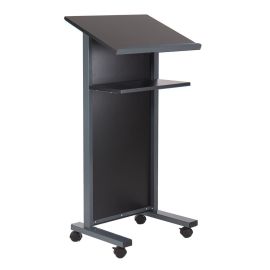12 Ways to Command an Audience from Behind a Lectern
- 23 Mar 2020

12 Ways to Command an Audience from Behind a Lectern
Do you have a presentation coming up? Are you planning to give a talk to a group of colleagues, investors, or students? It pays to brush up on your presentation skills, and work on being a good speaker – and a good leader.
Standing behind a lectern, speaking in front of an audience – for some people, it’s enough to make their knees go weak and all of the blood drain from their face. Public speaking may be a common phobia, but it doesn’t have to be overly stressful. As long as you are well prepared, you can deliver your presentation with aplomb and calm your nerves.
Planning your presentation should involve careful research and practice, but more importantly – you need to understand what captures an audience’s attention, and how to keep them interested. Good presentation skills are a key part of being a good leader, and so it pays to hone your prowess behind a lectern.

Command your audience from the lectern, and get results.
In order to give a good presentation, you must be a good leader. In order to be a good leader, you must be focused, present, and ready to give your audience information they can use. The following points are adaptations of theatre techniques and presentation tips from the experts, all designed to help you wow your audience and capture their attention.
- Nail the ‘take – off’ and ‘landing’
In order to command your audience’s attention from behind your lectern, you must take your cue from pilots. Think of your presentation or talk as if it is a flight – the most important parts? The ‘take off’ and ‘landing.’
Essentially, you need to start strong and end even stronger. While you should hone and practice your entire presentation, pay special attention to the beginning and the end. - Give your audience an agenda of your presentation
If you are giving a presentation longer than 15 minutes or so, make sure that you advise your audience on exactly what you plan to do and say. Doing this reassures your audience that they are in good hands, and helps them to build confidence in your abilities. As Dale Carnegie said, “Tell ‘em what you’re going to say, say it, then tell ‘em what you’ve said.” - Building confidence is key
We know that you might not feel the most confident before you take to the stage, but you must present the image that you do. People will be much more likely to listen to what you are saying if they have confidence in who you are as a person.
Speak in a loud and even manner, and pay special attention to your body language (more on this later). You could have the most brilliant things to say, but if you lose the confidence of the crowd, you have lost the plot. - Check your facts
Ideally, everything that you say from behind the lectern should be 100% accurate and thoroughly fact-checked. Most importantly, everything that you project on slides or print on hand outs needs to be beyond reproach. If you present inaccurate information, you will have lost all credibility with your audience. Check your facts, and then check again. - Stop fidgeting and move with purpose
We all have bad habits when we are nervous, and many of us end up tapping our toes, clicking a pen, or fidgeting in some other way. If you want your audience to trust you, you need to appear confident and self-assured.
Practice your presentation in front of a mirror so that you are aware of your own jerky or distracting movements. Make your movements behind the lectern purposeful and as minimal as possible. Avoid having too many objects near you – a pointer and a simple glass of water should be the only things within reach. - Use the space behind the lectern to your advantage
While you should avoid awkward, fidgeting, or jerky movements, that doesn’t mean that you should be still and static. On the contrary, assess the space that you have and make it count.
Move out from behind the lectern, make large and purposeful gestures with your body, and stride across the stage, if possible. That said, make sure that you don’t ‘pace’ like a caged tiger – this will make you look weak and nervous. - Use stories to illustrate your points
For as long as humans have been speaking, they have been telling stories. Any good leader knows that storytelling is a powerful tool that can illustrate complex concepts and explain data.
Use targeted stories to evoke emotions, inspire action, and get a good belly laugh from your audience. Just make sure that your stories are connected to your point, and that they do not meander or go off topic. You’ll be surprised how emotionally engaged people can become when you tell them a good story. - Project confidence and authority with your voice
If you are nervous, your voice might quaver, stammer, or quake. If this is something you are worried about, you should seek the help of a trained vocal coach. A weak voice can make your audience think that you have weak points, or that you are unsure about what you are saying.
Even if you can’t afford or don’t want to use a vocal coach - practice, practice, practice. It can help to record yourself speaking, and listening or watching what you look and sound like. This can help you identify strange tics and habits that could be distracting to your audience. - Don’t overwhelm your audience with a wall of text
Some orators choose to eschew PowerPoint or visual aids, as they find that these can distract your audience from what you are saying and the impact of your message. If you do choose to use PowerPoint, make sure that you do not simply just print your presentation on the slides.
Audiences get overwhelmed by a ‘wall of text’ and they will naturally stop listening to you and start reading ahead. Instead, use a few key words and phrases, and use photos and illustration to highlight and accompany your points. - Be clear and concise
While you might feel like you can ‘talk forever about this topic,’ going into your talk without preparation is a recipe for disaster. Write your presentation, and then cut it down, and cut it down again. Be as concise and clear as possible, and make sure that you are not giving unnecessary information that will bore your audience, or lead them off topic.
The best way to be clear and concise when you are behind the lectern? We’ve said it before – but practicing is the most important thing you can do! - Show your audience that you are passionate about your topic
It is much more exciting to listen to someone who speak when their passion for the topic comes through. Even if you initially disagree with what someone has to say, when they express it in a passionate way it can help you come around to their side. Just remember that there is a big difference between ‘passionate’ and ‘fanatical! - Tailor your style to your audience
One of the best ways to get the audience ‘on your side’ and listening keenly to what you have to say is to tightly tailor your style to who you are speaking to. You wouldn’t speak casually to a group of senior lawmakers, but similarly, you shouldn't be overly formal if you are addressing teenagers! Be as conversational as the setting allows, and adjust your delivery to the people in the crowd. Even if you plan to appear ‘off the cuff,’ you still need to go into the presentation well prepared and practiced.
Read more: 6 Great Public Speakers and What You Can Learn From Them





Looking for lecterns for sale?
As you are preparing to give a presentation, you should take some time to prepare your tools and equipment. Test your projectors, microphones, and other A/V equipment to ensure that everything is working smoothly and without a hitch.
Similarly, have a look at your current lectern and make sure that it is in good condition, without any damage or a wobble. Lecterns add a professional touch to your presentation, and give you a place to set notes in an organised fashion.
If you are looking for lecterns for sale, get in touch with the team at Red17. We are here to answer your questions and help you select the ideal lectern for your needs.
Read more: Choosing the Right Lectern for Your Venue
Shop here:












